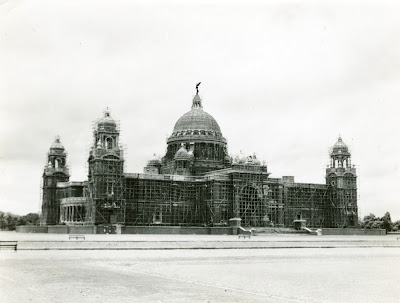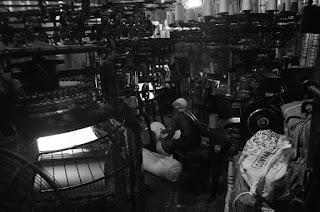Sir William Emerson,
President of the British Institute of Architects, designed and drew up
the plan of this building, while the work of construction was entrusted
to Messrs. Martin & Co. of Calcutta. Vincent Esch was assigned to
supervise the construction.
The building is 184 ft high
upto the base of the figure of Victory, which is another 16 ft high. The
groups of figures above the north porch represent Motherhood, Prudence
and Learning. Surrounding the main dome are figures of Art,
Architecture, Justice, Charity etc.The Memorial is situated on a 64
acres of land with the building covering 338 ft by 228ft.
The
total cost of construction of this monument amounting to one crore, and
five lakhs of rupees (Rs.1,05,00,000/-) was entirely derived from their
voluntary subscriptions. The Architect entrusted with the design was W.
Emerson. A pupil of William Burges, Emerson had first visited India
almost forty years before. His early works in the sub- continent
included the famous Crawford Markets in Bombay (now Mumbai) in 1865 and
the splendid but incomplete All Saints Cathedral in Allahabad
(1869-1893). In these and some other early projects Emerson experimented
with medieval Gothic styles, in the manner of his teachers. But the
design of his other great work in Allahabad, Muir College in 1873, is
more eclectic. Drawing on Venetian, Egyptian and Deccani sources, this
was one of the first essays in the Indo-Saracenic Movement. Like the
contemporary Senate House in Madras (now Chennai) by R. F. Chisholm, it
is a colourful and extravagant building, combining forms from the
Islamic architecture of various regions with a European structure.
Moving from British India to the princely state of Bhavnagar in Gujrat,
Emerson continued in a similar way with the Takhtsingji Hospital (1879 -
93) and the Palace (1894 - 95). Here at the request of his patron, he
introduced forms from Hindu architecture, such as corbelled arches.
Now based in England and approaching sixty, Emerson was
clearly going to need an assistant, to supervise the construction of the
building on site. The man appointed for this role was Vincent J. Esch. A
generation younger than Emerson, Esch had like him, gone out to India
at the start of his career and in 1899 he was appointed Assistant
Engineer in the Bengal Nagpur Railway, a job which gave him much
practical experience in large-scale construction and costings. In the
New Year of 1902, Emerson engaged him to prepare a sketch of his
original design for the Victoria Memorial and anxious to avoid any
involvement of the Public Works Department, urged the Viceroy to put him
in charge of the plan's implementation. More cautious, perhaps, Curzon
seems to have tested Esch out with a couple of minor commissions. He
employed him to design a Circuit House, bombarding him with advice to
adopt the "simple old Italian style". At the same time, Esch prepared
designs for the temporary Exhibition Building for the Delhi Durbar of
1903. In this case, consistent with his general plans for the Durbar,
Curzon required something in the Mughal style, and he was pleased to
find Esch compliant.
Even so, the appointment was not
immediate. Building operations on the Memorial were slow to get started,
and had not properly begun by the time Curzon left India at the end of
1905. They were then subject to further delays as his successors had
less enthusiasm for this inherited scheme, and lengthy tests had to be
made on the foundations. Meanwhile, the real break in Esch's career came
in 1907 when he won the competition to design the Bengal Club, a
prestigious building on a conspicuous site on Chowringhee. At the same
time, he was concluding his service with the Bengal-Nagpur Railway by
designing their new head office at Garden Reach. These two projects won
him a reputation for capable design and efficient management, and
launched him in private practice. By the time the construction of the
Memorial began in earnest, in 1910, Esch had established himself as
Calcutta's leading architect. He was then formally appointed the
project's Superintending Architect. Esch's major clients in Calcutta
included the Allahabad Bank, the Royal Calcutta Turf Club, and Duncan
Brothers. From 1914 to 1921, he was also employed by the Nizam of
Hyderabad, in an extensive reconstruction of the Nizam's capital. Esch
designed numerous large public buildings in Hyderabad, including the
Railway Station, the High Court, the City High School, and the Osmania
Hospital.
Like many others, too, he could not help
comparing the Memorial with the Taj Mahal. There is a certain
resemblance with , more than the details mentioned which, lends the
building a pervasive Indian character. It arises, first, from the
material. From the very start, even before he expressed his views on its
style, Curzon insisted that the Memorial should be built of white
marble, and in the event the stone was brought from the same quarries in
Makrana, Rajasthan, that supplied Shah Jahan. There is also a
correspondence in the forms: the great dome, clustered with four
subsidiary, octagonal domed chattris, the high portals, the terrace, and
the domed corner towers. There is even some correspondence in the
function: like Shah Jahan, Curzon conceived the building as a memorial
to an Empress and as a powerful visual statement. This linking of the
Mughal and British periods is sustained by the collection of exhibits
within; and it is typical of the self-presentation of the late Raj, of
which Curzon's Delhi Durbar and the whole Indo-Saracenic movement are
further examples. In this context, the echo of the Taj Mahal need not
have been an effect deliberately sought by the architect; but it is
evident that Emerson greatly admired the Mughal masterpiece - a youthful
lecture on it which he delivered to the RIBA in 1870 was a sustained
panegyric.

A less desired similarity with the Taj Mahal
was the length of time it took to build. Following the conception and
design in 1901, construction of the substructure began in 1904. The
visiting Prince of Wales laid a foundation stone in 1906, but it was a
further four years before work on the superstructure got under way. On
January 4, 1912, the Prince - now King George V - returned to inspect
progress. In the preceding month in Delhi the royal visitor had been
crowned Emperor, and in his speech on that occasion, he had announced
the transfer of the capital to Delhi. Curzon had not foreseen this move
and he much lamented it; it left his sanctum of the Empire high and dry
in a provincial city even before it was completed. The work continued,
but it was not until December 28, 1921 that another Prince of Wales came
formally to open it. On the same tour, the Prince visited Hyderabad,
where he saw Esch's buildings all but finished; and he inspected
progress on the buildings in New Delhi, which already promised to
surpass the Memorial in grandeur. Curzon's project had been overtaken by
events.
If the Memorial's impact was diminished by
delay, it was still a splendid gesture. Emerson's design was much
enhanced by the sympathetic ornaments added by others. Vincent Esch's
major contribution was the redesign of the foundations on innovative
principles for which he was renowned, but he also supervised the
production of the allegorical sculpture groups over the entrances and
designed the elegant bridge on the north side, and the gates to the
gardens. The gardens themselves were laid out by Lord Redesdale and Sir
David Prain; their spaciousness and restraint emphasize the building's
majesty. In the central hall, scenes from the life of the Queen were
painted by Frank Salisbury, and the marble statue of the young Queen is
by Sir Thomas Brock. A more elderly Queen in bronze by Sir George
Frampton, sits enthroned on Esch's bridge, between narrative panels by
Sir Goscombe Jhon. In the paved quadrangles and elsewhere around the
building, other statues were added to commemorate Hastings, Cornwallis,
Clive, Wellesley, and Dalhousie.
The Queen may have
enjoyed their company, but whether these statues delivered an impartial
history lesson, as Curzon had intended, successive generations may judge
for themselves. Curzon himself seemed to consider impartiality achieved
by the exhibition within, but equally approved the unambiguous message
of the external ornaments.
"Much might be said about the
external sculptures, one of which on the north side depicts a lion's
head with water flowing out of it and passing into four troughs
representing the four great Indian rivers - the Ganges, the Krishna, the
Indus and the Jumuna - thus symbolising the life-giving work of Britain
in India."
--Saptarshi Chatterjee
















































